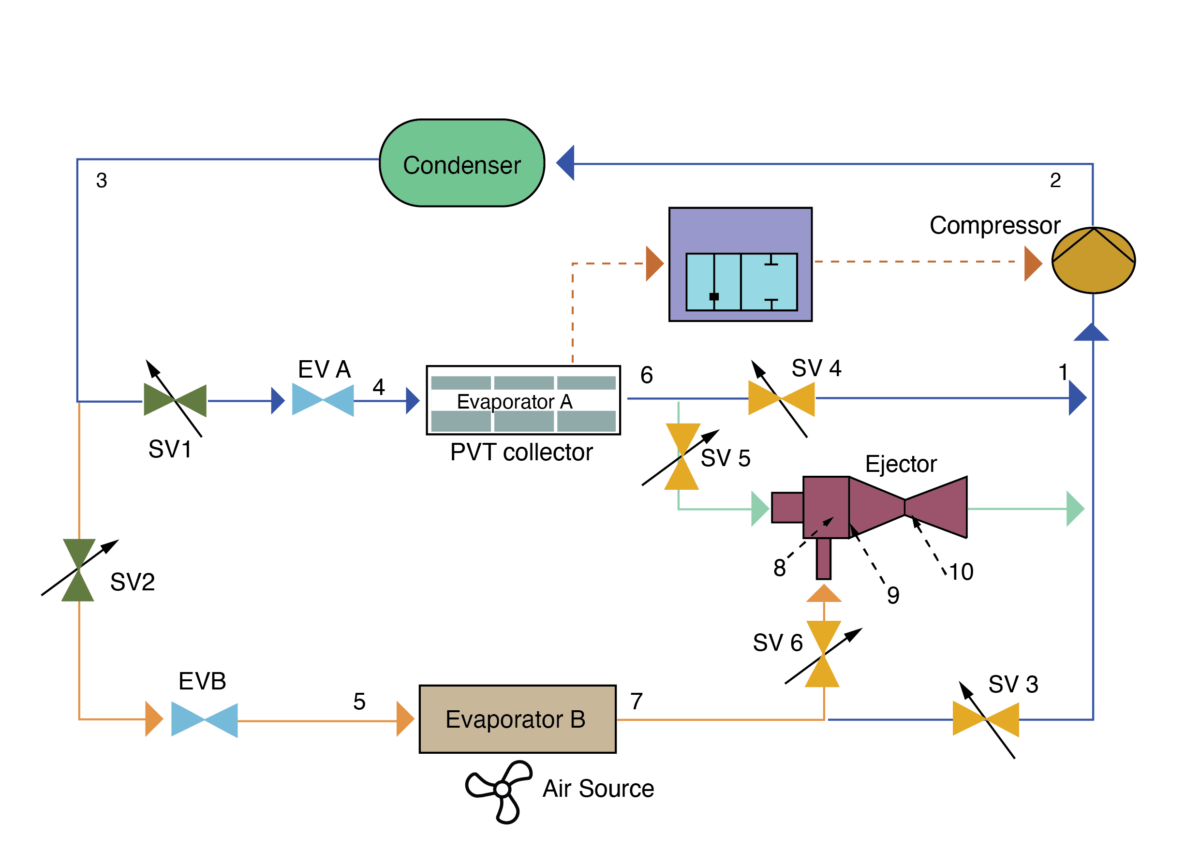Scientists from Chongqing University in China have designed a solar-air composite dual-source heat pump system for water heating in self-built rural houses in the Beijing-Tianjin-Hebei region of China.
“Our system can maintain stable heating performance even in adverse weather scenarios with low temperatures or limited solar radiation,” the research's corresponding author, Jun Lu, told pv magazine.
The researchers described the proposed system as an ejector-enhanced solar-air composite dual-source heat pump (EDHP) that uses photovoltaic-thermal (PVT) collectors. The heat pump initially uses a compressor to compress low-temperature and low-pressure vapor into high-temperature and high-pressure superheated vapor.
This vapor is then divided into the PVT collectors and an air-source heat exchanger while passing through expansion valves that adjust the required pressures based on solar irradiance intensity and ambient temperature. “The ejector leverages the high-pressure refrigerant as the driving mainstream to increase the pressure of the low-pressure refrigerant,” the academics explained. “After that, the mixed refrigerant from the ejector outlet returns back to the compressor.”
The system also uses an inverter to store the electricity generated by the PVT modules in the batteries or to convert direct current (DC) into alternating current (AC) that can be used to power the compressor or injected into the grid.
The heat pump works with three operating modes: in solar-assisted mode, with the heat needed for the heating process being provided by the PVT collectors; with insufficient solar radiation, when both the air-cooled evaporator and the solar collector/evaporator operating simultaneously; and with using ambient air as the primary heat source, which reportedly ensures continuous heating operation.
The academics conducted a series of simulations to assess the performance of the heat pump system and analyzed, in particular, the thermodynamic properties of the working fluid – the environmentally friendly refrigerant R134a. “The ejector plays a crucial role in improving the circulation performance of vapor compression cycles,” they stated. “As the primary flow pressure of the ejector increases, the coefficient of performance (COP) rises, while the COP decrease occurs concurrently with the decrease of the secondary flow pressure of the ejector.”
They assumed the system operated at a temperature of -5 C and an irradiance level of 250 W/m2. They also considered utilizing 20 m2 of PVT collectors for a heating supply of 5 kW.
The assessment showed that the heat pump was able to achieve a COP of 4.271, which the academics said is over 25% more than that achieved by conventional air-source heat pumps. “The reduction in electricity demand from the grid can reach up to 51.96 % by incorporating the electricity generated from the PVT panels,” they added.
They estimated the system's payback period at between 10 and 12 years.
The system was described in the paper “Thermodynamic and economic analyses of modified ejector enhanced solar-air composite dual-source heat pump system in residential buildings,” published in Energy and Buildings.
This content is protected by copyright and may not be reused. If you want to cooperate with us and would like to reuse some of our content, please contact: editors@pv-magazine.com.




By submitting this form you agree to pv magazine using your data for the purposes of publishing your comment.
Your personal data will only be disclosed or otherwise transmitted to third parties for the purposes of spam filtering or if this is necessary for technical maintenance of the website. Any other transfer to third parties will not take place unless this is justified on the basis of applicable data protection regulations or if pv magazine is legally obliged to do so.
You may revoke this consent at any time with effect for the future, in which case your personal data will be deleted immediately. Otherwise, your data will be deleted if pv magazine has processed your request or the purpose of data storage is fulfilled.
Further information on data privacy can be found in our Data Protection Policy.